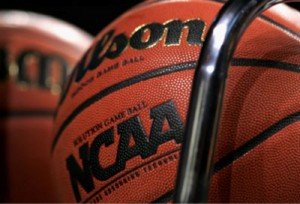The hypocrisy of American university sports

American university sports are founded on the idealistic notion of amateurism in the form of student-athletes. Supposedly, what matters is the personal growth of the students, and the school spirit fostered by competition. Perhaps this was once the case, and perhaps in some corners it remains the case. However, at the largest American universities this has long ceased to be the motivation. Instead, schools are motivated solely by profit. There is nothing inherently wrong with schools earning a profit from athletics, however the profits often result in the exploitation of the athletes involved.
The NCAA basketball championship tournament, March Madness, is currently ongoing. All of the games are televised, and billions of dollars are gambled on the results of the games. CBS and Turner Broadcasting paid almost eleven billion dollars to the NCAA for the right to broadcast the tournament. The NCAA also brings in significant profits from sponsors and ticket sales. All of the schools that participate receive a portion of the revenues. The schools are able to invest this revenue in several ways, including paying coach salaries, and funding less profitable athletic programs.
Successful, high profile athletic programs, including mainly basketball and football programs, are used by large schools to attract significant donations from alumni, adding to the funds that athletic success can generate for the schools. The high level athletes, in short, provide significant value to the schools. The problem is that for their efforts, the athletes receive very little in return. Most often they receive a full scholarship that is contingent on athletic success. If an athlete is injured, or fails to produce, his or her scholarship is often revoked. The education that the athletes receive is often subpar, especially for athletes in elite athletic programs. The athletics can be such a significant time commitment that it is unreasonable to expect participants to also be successful students. But, these students are not simply receiving poor grades, and in many large universities more than half of student athletes fail to graduate. They simply exhaust their athletic eligibility then move onto other things.
The scholarship is often the full extent of what the athletes receive from the school. They provide potentially millions of dollars of value to the schools, and commit essentially all of their time attempting to produce at near professional levels, and not even their incidental living expenses are provided for. In fact, according to NCAA rules, if a student accepts money from the school or supporters of the school they can be removed from the team and lose their scholarship. The schools are often also punished in these situations. So schools are permitted to profit from the labor of the athletes, while the athletes themselves are not.
Additionally, student-athletes are not permitted to profit from their image or likeness while they are at school. They can be punished for something as simple as selling autographs. The NCAA and the school retain the exclusive right to profit and market the images of athletes, in the form of merchandise. The athletes get nothing in spite of the fact that the students themselves are responsible for the value of what is being sold.
The NCAA has significant incentives in place to retain the existing system of exploitation of the student-athletes. The schools continue to profit exorbitantly, the general public is happy to consume the university athletics product, and the students have very little power to change the system, and get fairly compensated for their work.
There is an argument to be made that the exploitation is doing a certain form of good since the money is being used to fund universities, either their other athletic programs which are less profitable or simply their general funds. However, despite any good that the money may do for the schools, it is still obtained under the false pretense of amateur athletics. An enterprise that is this profitable and attracts this much attention could not possibly be considered to be amateur. The only reason that the NCAA continues to insist on calling its product amateur athletics is to maintain the exploitation of its labour force, the athletes. Instead of using the profits of the handful of profitable athletic programs to fund the numerous truly amateur athletic programs, the cost and number of the less profitable athletic programs should be somewhat decreased, and the students should be permitted to retain a larger portion of the profits that they themselves generate.
There appear to be some beginnings of a push for change in these areas. A number of former NCAA basketball and football players sued the NCAA for the use of their images in videogames without compensating them. The NCAA and their partners settled these lawsuits for a total of sixty million dollars, but have not yet changed their rules to allow for compensation of athletes for similar uses now and in the future. A group of football players from Northwestern University recently established a union, and submitted a complaint to the US National Labor Relations Board, but this claim has not yet been resolved in any way. The hope from the perspective of the players is that this union will grow and eventually force the NCAA to more fairly compensate the players. Until then, the NCAA remains a strange, unfair organization. It produces some of the most popular, profitable sports content in the world, and continually refuses to acknowledge the interests of the players who drive it. Now that’s madness.
